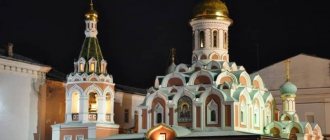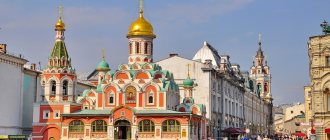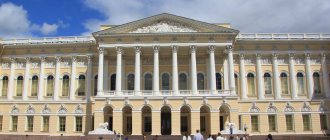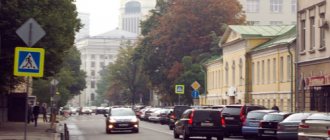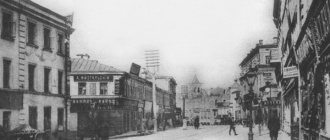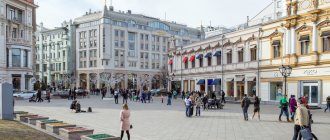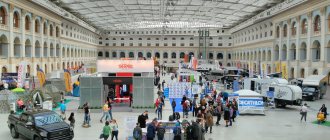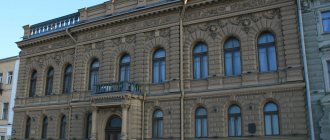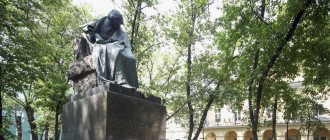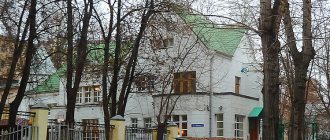This term has other meanings, see Mokhovaya Street.
| Mokhovaya street | |
| Mokhovaya Street | |
| general information | |
| A country | Russia |
| City | Moscow |
| District | Central Administrative District |
| Area | Arbat (No. 9/4/3 - residential, No. 3-9 - non-residential), Tverskoy (No. 11 - 15/1 and 6/16 - non-residential) |
| Length | 0.6 km |
| Metro | Okhotny Ryad Alexandrovsky Garden Borovitskaya |
| Postcode | 125009 (odd, except No. 7, and 8/13), 119019 (even); 103265 (No. 7 - Reception of the State Duma), 103429 (No. 7 - Reception of the Federation Council) |
| Phone numbers | +7(495) XXX—- |
| Media files on Wikimedia Commons | |
Mokhovaya
(1961-1990 - part of Marx Avenue) - a street in the center of Moscow. The street starts from the Borovitskaya Tower of the Kremlin, goes north, and Tverskaya, Bolshaya Nikitskaya and Vozdvizhenka streets depart from it to the left. It ends at Manezhnaya Square. The continuation is Okhotny Ryad Street. The numbering of houses starts from the Borovitskaya Tower.
Buildings and structures[ | ]
On the odd side:
| Ill. | Address | Name | Years of construction, architect | Description |
| No. 1 (official address: Vozdvizhenka, 3/5С1) | Pashkov house | 1784-1788, the authorship of the project is attributed to V. I. Bazhenov | Now the Department of Manuscripts and a number of other divisions of the RSL. | |
| Combined ground lobby of the Borovitskaya and Lenin Library metro stations. | 1935; 1986, architects L. N. Popov, V. S. Volovich and G. S. Moon | Opened on May 15, 1935 as the lobby of the Lenin Library station. On January 23, 1986, it was opened after reconstruction as a combined station for two stations. | ||
| № 3 | Russian State Library | 1928-1958, architects V. A. Shchuko and V. G. Gelfreich | The building was built for the State Library of the USSR named after. V. I. Lenin. The library includes six buildings, including a 19-story book depository. | |
| Monument to F. M. Dostoevsky | The sculpture by A.I. Rukavishnikov was installed in 1997. | |||
| No. 7 (aka: Vozdvizhenka St., 4/7) | Former Peterhof Hotel | 1901, architect V.V. Shaub | The building was rebuilt in 1901 from the previously existing buildings of E. M. Skvortsov in the second half of the 19th century. for the Russian Society for Insurance of Capital and Income, which opened furnished rooms “Peterhof” there. In 1919-1946. the reception room of M.I. Kalinin was located; Leon Trotsky lived here[5]. Nowadays it is the reception room of the State Duma of the Federal Assembly of the Russian Federation. To the right is the entrance to the built-in Business (2002). | |
| No. 9, page 4 | PIRAO | 1911, architect A. S. Grebenshchikov | Psychological Institute of Moscow University, a cultural heritage site of regional significance[6], now the Institute of Psychology of the Russian Academy of Education. Located in the courtyard of the Moscow State University Library. | |
| No. 9, page 7 | "The Priest's House" | 1832, architect E. D. Tyurin | “The Priest’s House” (former service building of the Main Moscow Pharmacy), now the printing house of the Faculty of Journalism of Moscow State University. Located deep in the yard. | |
| No. 9, page 9 | 1901, architect K. M. Bykovsky | The old building of the Moscow University Library (moved to the Lenin Hills). Now its Department of Rare Books and Manuscripts, the funds of the faculties of journalism, psychology, arts, and ISAA are located here. | ||
| No. 9, page 1 | Faculty of Journalism | 1832-1835, architect E. D. Tyurin, in 1901-1905 expanded by K. M. Bykovsky | Originally the house of D.I. and A.I. Pashkov from the beginning of the 18th century. In 1833, it was purchased for Moscow University and rebuilt: the main house, the residential building on Bolshaya Nikitskaya Street and the end facing Mokhovaya Manege were combined into a single building. Now - Faculty of Journalism of Moscow State University. | |
| No. 9, page 10 | 1930s | Outbuilding | ||
| No. 9, p. 2 | Church of the Martyr Tatiana at Moscow State University | 1834, architect E. D. Tyurin | A former university theater, converted into a church, then into a Soviet cultural center, then back into a church. | |
| No. 11, page 1 | Old building of Moscow University | 1786-1793, architect M. F. Kazakov; 1817, architects D. I. Gilardi, D. G. Grigoriev; in 1920-1921 restoration of the building was carried out by I. P. Mashkov, D. S. Markov and I. E. Grabar[7] | Now - the Institute of Asian and African Countries at Moscow State University and some other departments of Moscow State University. In front of the building there are monuments to A. I. Herzen and N. I. Ogarev (1922, sculptor N. A. Andreev) | |
| No. 11, p. 3 | Institute of Europe RAS | |||
| No. 11, page 7 | 1898-1901, architect K. M. Bykovsky | Previously the Physics Institute of Moscow University, now the Institute of Radio Engineering and Electronics. V. A. Kotelnikov RAS. Located deep in the yard. | ||
| No. 11, p. 8 | 1877, architect A. A. Nikiforov | Anatomical building of Moscow University. Located in the courtyard behind the Geological Museum. | ||
| No. 11, page 9 | Faculty of Psychology | 1914, architect R.I. Klein | Mineralogical building of Moscow University, currently the Faculty of Psychology of Moscow State University. Located deep in the yard. | |
| No. 11, page 11 | 1914, architect R.I. Klein; rebuilt in the 1950s[8] | Previously the Geological Building of Moscow University, currently the State Geological Museum named after. V. I. Vernadsky RAS. In 1930-1987 The Moscow Geological Prospecting Institute was located here. | ||
| № 13 | Zholtovsky's house on Mokhovaya | 1932-1934, architect I. V. Zholtovsky | A residential building nicknamed “the nail in the coffin of constructivism.” The house was given to the US Embassy (the building occupied until 1953), and then to Intourist. Nowadays OJSC "Joint-Stock Financial Corporation "Sistema"". It was reconstructed several times, as a result of which only the façade wall remained of Zholtovsky’s building. | |
| № 15/1 | Hotel National | 1901-1902, architect A. V. Ivanov. The majolica panels on the upper floor were made at. The author of the modern panel in the corner of the building is I. I. Rerberg. | The building was built for the Varvara joint-stock company. Since 1918 - 1st House of Soviets, hotel since the late 1920s. |
On the even side:
| Ill. | Address | Name | Years of construction, architect | Description |
| Borovitskaya Square | ||||
| "Nixon's Lawn" | At this place there was a block of old residential buildings, which, according to legend, were demolished for Richard Nixon’s visit to Moscow in 1972. The Soviet linguist S.I. Abakumov lived in one of the houses (No. 4). | |||
| Monument to Vladimir the Great | The sculpture by Salavat Shcherbakov was installed in 2016. | |||
| № 6 | City estate of the Shakhovskys - Krasilshchikova | 1886, architect S. S. Eibushits together with A. S. Kaminsky[10] | The main house with outbuildings and services of the Shakhovsky princes - Krasilshchikova. In the 19th century Household No. 6 belonged to Ivan Kozmich Baklanov, who together with his brother, Nikolai Kozmich, owned the Babkinskaya manufactory. Then, due to their financial difficulties, the mansion was sold to the Siberian millionaire Yu. I. Bazanova (which is why this part of Moscow was called “Bazanovka”)[11]:325, in 1906 it became the property of the wife of manufacturer Nikolai Krasilshchikov, Elizaveta Krasilshchikova (nee Druzhenkova) . Since the early 1930s, the first building of the Moscow Library Institute and the Literary Museum at the All-Union Library named after. Lenin, since 1934 - State Literary Museum. In 1950-1991. - M.I. Kalinin Museum. | |
| No. 8, page 1. | 1823, 1907, architect Kvashin | Residential outbuilding (with a fragment of a fence and a pylon) of the city estate of the Ukhanov merchants - M. N. Pushchina. | ||
| No. 8, p. 2. | The building was built in the 1970s and reconstructed in the 1990s. | Tavern "Taras Bulba" | ||
| No. 10, p. 2 | 1892, architect M. A. Arsenyev | The apartment building of the Brotherly-loving Society in Moscow for providing apartments to the poor. During the war, the building was hit by an aerial bomb, dividing it into two buildings[12]. | ||
| № 12 | 1865-1868, architect P. A. Gerasimov, 1900s, 1955 | The stable building of the Business Yard of the Moscow Palace Office with outbuildings. | ||
| № 14 | The first and second floors were erected in 1825 (according to other sources - in 1818 based on the structure of the 1790s), the third floor in 1893, architect F.V. Rybinsky | Former apartment building of the Polyakov merchants. Nowadays there is a Group for Expert Evaluation of Printed Works at the Russian State Library. | ||
| No. 16 Official address: st. Vozdvizhenka, 1. Aka: Manezhnaya st., 13. | The first and second floors were erected in 1836-1838, reconstructed in 1875, the third and fourth floors in 1912. | House of commerce-advisor to the merchant of the 1st guild A.L. Torletsky. Apartment house of Prince G.G. Gagarin. The building houses one of the vestibules of the Alexandrovsky Sad metro station. From 1919 to 1937, the building housed the Executive Committee of the Communist International (in 1937 the committee moved to a building in the Lenin Mountains area)[13]. | ||
| Sapozhkovaya (Sapozhkovskaya) square with Kutafya Tower | ||||
| № 18 | Moscow Manege | 1817, architects O. I. Bove, A. A. Betancourt; 2004, P. Yu. Andreev - reconstruction after the fire | Built for guards equestrian exercises. In Soviet times - a departmental garage, since 1957 an exhibition hall. Nowadays it is the Central Exhibition Hall “Manege”. | |
| Manezhnaya Square |
Mokhovaya street
The first mention of this street dates back to the 15th century. Then at its beginning, on the site of the old State Library building, stood the country palace of Grand Duchess Sofia Vitovna, daughter-in-law of Dmitry Donskoy. In 1565, Ivan the Terrible, between modern Vozdvizhenka and Bolshaya Nikitskaya streets, built his palace - “Oprichny Dvor”. The buildings in it were wooden, but they were surrounded by a high stone wall with strong gates. The courtyard was filled with white sand brought from the Sparrow Hills, which was used to determine the exact location of the Oprichnina Court during the construction of the metro in 1934. The courtyard did not last long - in 1571 it was burned to the ground by the Crimean Tatars who attacked Moscow. However, the courtyard was nevertheless restored, and in 1574-1575 Ivan the Terrible lived in it, and at the beginning of the 17th century - Prince D.I. Shuisky.
To serve the Oprichnina Court, the Streltsy settlement of the Stremyanny Regiment was settled on the square between it and the Kremlin, which remained here until the end of the 17th century. When laying the metro in ancient wells, Streltsy axes, pots, etc. were discovered here. The Streltsy of this regiment accompanied and guarded the Tsar on military and pilgrimage campaigns.
In the 17th century, on the hill, on the site of the old building of the State Library, stood the courtyard of the Shuisky princes, and at the end of the century - the Duma clerk Avtamon Ivanov; in front of him below was the Church of St. Nicholas Streletsky with a cemetery. The second courtyard on the mountain was the courtyard of the Church of Mikhail Malein, and under the mountain there were Turgenev’s church almshouses; on the site of the new buildings of the State Library, near Vozdvizhenka Street there was a courtyard of the Streshnev boyars, which at the end of the century passed to the Naryshkins.
The southern side of Mokhovaya Street between the Trinity and Borovitsky Gates of the Kremlin was occupied in the 16th-17th centuries by the Apothecary Garden, the courtyards of the archers, the clergy of the Kremlin churches and others. Opposite the Trinity Gate at the beginning of modern Vozdvizhenka Street, stood the Church of St. Nicholas in Sapozhka. On the site of the arena there was a square along which roads from Znamenka Street and Tverskaya Street led to the Trinity Gate, only in the 17th century were they brought together into one straight Mokhovaya Street.
In the 18th century, house No. 1 on Mokhovaya (now the State Library) was owned by Prince A.A. Menshikov, and in 1782 moved to P.E. Pashkov, a descendant of Peter I’s orderly, for whom the famous architect V.I. Bazhenov built a magnificent building that still serves as a decoration for the street. In front of it was a beautiful garden with ponds. The historian V.N. built his house on the site of the Turgenev almshouses. Tatishchev. The neighboring house continued to remain in the hands of the Naryshkins. The house of Prince Repin on the corner of Bolshaya Nikitskaya Street was already bought for the university in 1758, later Catherine II bought other houses for it, and in 1786-1793 the famous architect M.F. Kazakov erected a magnificent building (now an old building) of the university here.
In the fire of 1812, the university and some other houses on Mokhovaya burned down. The old building, built by Kazakov, was restored and re-architected in the Empire style by D. Gilardi in 1817. In the same year, the Manege building was built on the site of Mokhovaya Square. It was built according to the design and under the leadership of A. Betancourt by the Russian engineer Kashperov, designed by O.I. Beauvais. Initially, the arena was intended for military exercises. In the nineteenth century, soldiers' lives and health were valued. In bad weather, drill reviews and training took place indoors. The wooden structure of the arena ceiling, which did not have any support except for the outer walls, was a miracle of the engineering art of its time.
In the first half of the 19th century, some houses were transferred to state institutions: “Pashkov House” was occupied by a noble institute in 1843, in 1849 by the 4th men’s gymnasium, and since 1862 by the Rumyantsev Museum and Library. In the mid-19th century, the Naryshkin house was occupied by the Mining Department, and from the 1870s by the Archives of the Ministry of Foreign Affairs.
The new university building, built at the end of the 18th century for D.I. and A.I. Pashkov as the main house of the estate, in 1833 it was purchased for the university and in the middle of the 19th century rebuilt by the architect E.D. Tyurin. The outbuilding on the corner of Bolshaya Nikitskaya Street was built by Tyurin in 1837 for the university church of Tatiana. In 1905, architect K.M. Bykovsky rebuilt the building: he added a room for a large auditorium and added a passage to the church. In 1876, a small bronze bust of M.V. was installed in the middle of the courtyard. Lomonosov (works by sculptor P. Ivanov) in 1945 it was replaced by a monument by S.D. Merkurova.
The last house on Mokhovaya Street, on the corner of modern Tverskaya, was replaced at the beginning of the 20th century by the six-story building of the National Hotel. In the 1930s, Mokhovaya Street was reconstructed. All buildings on the site of Loskutny, Obzhorny and other rows were demolished and Manezhnaya Square was formed. To expand Mokhovaya, between Vozdvizhenka and Znamenka, the remains of what was once here in front of the house of P.E. were demolished. Pashkov's magnificent garden, as well as Tatishchev's old house. In 1961, Mokhovaya Street changed its name and became part of Marx Avenue, but in 1990 its historical name was returned to it. District: Central, Arbat, Tverskoy. Nearby metro stations: Lenin Library, Borovitskaya, Okhotny Ryad.
Notes[ | ]
- ↑ 12
Moscow: all streets, squares, boulevards, alleys / Vostryshev M. I. - M.: Algorithm, Eksmo, 2010. - P. 345-347. — ISBN 978-5-699-33874-0. - I. M. Snegirev.
Moscow. - Ripol Classic, 2013. - 333 p. — ISBN 978-5-458-01862-3. - Yuri M. Nagibin.
Alarming ringing. Book about Moscow: book about Moscow. - Ripol Classic, 2010. - 314 p. — ISBN 978-5-386-02158-0. - Sergey Shokarev, Mikhail Vostryshev.
All Moscow from A to Z. - Litres, 2018-02-04. — 1060 s. — ISBN 978-5-04-101379-0. - Trotsky Lev Davidovich // Moscow Encyclopedia. / Ch. ed. S. O. Schmidt. - M., 2007-2014. — T. I. Faces of Moscow: [in 6 books].
- Register of historical and cultural monuments (unspecified)
(inaccessible link). Official website of Moskomnaslediya. Access date: October 2, 2011. Archived February 1, 2012. - Brandenburg B. Yu., Tatarzhinskaya Ya. V., Shchenkov A. S.
Architect Ivan Mashkov. - M.: Russian Book, 2001. - P. 86. - 136 p. — ISBN 5-268-00413-1. - Vaskin, Golstadt, 2009, p. 243-244.
- Moscow Encyclopedia / S. O. Schmidt. - M.: Publishing House, 2007. - T. I, Faces of Moscow. — P. 8. — 639 p. — 10,000 copies. — ISBN 978-5-903633-01-2.
- Register of historical and cultural monuments (unspecified)
. Official website of Moskomnaslediya. Access date: February 5, 2010. - N. A. Varentsov.
Heard. Seen. Changed my mind. Experienced / Intro. article, comp., prep. text and comment. V. A. Lyubartovich and E. M. Yukhimenko. - 2nd. - M.: New Literary Review, 2011. - 848 p. — (Russia in memoirs). — ISBN 978-5-86793-861-1. - Unusual monuments of Moscow - “Torn” house
- A number of foreign researchers believe that this move of the governing body of the international communist movement from the center of Moscow to a less “prestigious”, at that time, area of the city took place as part of the curtailment of the course towards the “world revolution” and the final transition of the top leadership of the USSR to building socialism in one, a single country. One of the direct eyewitnesses of the events, a former Comintern functionary and political prisoner, and later an employee of Radio Liberty, Wanda Pampusz-Bronska writes that the move of the ECCI from the street. Mokhova to the Lenin Hills was intended to demonstrate the loss by the Comintern of the priority role that it had played since its establishment. see Brońska-Pampuch, Wanda
[pseud.
Alfred Burmeister
]. Dissolution and Aftermath of the Comintern: Experiences and Observations, 1937–1947. - NY: Research Program on the USSR, 1955. - P.14 - 43 p. — (Mimeographed series; 77).
LiveInternetLiveInternet
Mokhovaya Street is located in the center of Moscow. It starts from Borovitskaya Square and stretches to the intersection with Tverskaya Street. Along its entire length, it is adjacent to Vozdvizhenka and Bolshaya Nikitskaya streets, as well as Manezhnaya Square. Mokhovaya Street - origin of the name According to various sources, the street received its unusual name - “Mokhovaya” - in the 17th or 18th centuries. This name is not associated with the presence of marshy areas in these parts at the time of the birth of Moscow, but with the sale of moss at the Trinity Gate of the Kremlin wall for caulking wooden buildings and huts.
At first the square where trade was carried out was named Mokhovaya, and then the street itself. Mokhovaya Street - history The first mention of the street located in this place dates back to the 15th century. Based on the chronicle, a country palace was built here for Dmitry Donskoy’s daughter-in-law, Sofia Vitovna, the Grand Duchess. In the mid-sixties of the 16th century, between the current Vozdvizhenka and Bolshaya Nikitskaya, the “Oprichny Dvor” was rebuilt. In 1571, its wooden buildings were burned by the Crimean Tatars, who attacked the mother throne. Only a high wall built of stone survived.
After the invasion, the Oprichnina Dvor was restored. At different times, Ivan the Terrible and Prince D.I. lived here. Shuisky. Opposite the oprichnina courtyard, between it and the Kremlin wall, they set up a streltsy settlement, consisting of streltsy of the Stremyanny Regiment. The duties of the latter included guarding and accompanying royal persons during military campaigns and pilgrimage trips. The settlement existed until the end of the seventeenth century. Part of the street, from the Borovitsky and Trinity Gates, was occupied by the Apothecary Garden in the 16th and 17th centuries. The houses of the clergy who served in the Kremlin churches were also located here. Until the seventeenth century, the families of the Streshnevs, Prozorovskys, Morozovs, Pushkins, and Repnins lived on the street.
In the eighteenth century, on the site of the current “Pashkov House”, there was the property of Prince A.A. Menshikov. Later he sold it to Peter the Great's orderly P.E. Pashkov, for whom the architect V.I. Bazhenov built a well-known house on the corner of Mokhovaya and Znamenka. The famous historian Tatishchev built his house at the location of the Turgenev almshouses. The house of Prince Repin, located at the intersection with Bolshaya Nikitskaya Street, was bought by Catherine the Great in 1758 for the needs of Moscow University. Later, for the same purposes, she acquired other buildings in these places.
In 1817, on the site of the former Mokhovaya Square, the Manege building appeared. It was rebuilt according to Betancourt's design, and engineer Kashperov supervised the work. The design was entrusted to the famous architect Beauvais. The National Hotel, on the corner of Tverskaya Street, was built at the beginning of the twentieth century. Mokhovaya and the surrounding area during the years of Soviet power
In the 30s of the last century, the street and its surroundings underwent significant changes. The buildings located in Obzhorny and Loskutny rows were demolished. In their place Manezhnaya Square appeared. A little later, to expand Mokhovaya, they sacrificed the magnificent garden in front of Pashkov’s house. Tatishchev's house on the street was demolished, as well as several churches and temples. In 1961, Mokhovaya became part of Karl Marx Avenue and only in 1990 its former name and boundaries were returned to it.
Literature[ | ]
- Vaskin A. A., Goldstadt M. G. Old Moscow within the boundaries of the Kamer-Kollezhsky Val. Along silk Vozdvizhenka, along suede Manezhnaya: Photo guide. - M.: Sputnik+ Company, 2002. - 102 p. ISBN 5-93406-348-0
- Muravyov V.B..
Moscow streets. Secrets of renaming. - M.: Algorithm, Eksmo, 2006. - 336 p. - (People's Guide). — ISBN 5-699-17008-1. - Vaskin A. A., Golstadt M. G.
From the demolished Voentorg to the burnt-out Manege. Historical photo guide. - M.: Sputnik + Company, 2009. - 400 p. — 2000 copies. — ISBN 678-5-9973-0100-2.
Literature
- Vaskin A. A., Goldstadt M. G. Old Moscow within the boundaries of the Kamer-Kollezhsky Val. Along silk Vozdvizhenka, along suede Manezhnaya: Photo guide. - M.: Sputnik+ Company, 2002. - 102 p. ISBN 5-93406-348-0
- Muravyov V.B..
Moscow streets. Secrets of renaming. - M.: Algorithm, Eksmo, 2006. - 336 p. - (People's Guide). — ISBN 5-699-17008-1. - Vaskin A. A., Golstadt M. G.
From the demolished Voentorg to the burnt-out Manege. Historical photo guide. - M.: Sputnik + Company, 2009. - 400 p. — 2000 copies. — ISBN 678-5-9973-0100-2.
"A city to remember." 241. Imperial Moscow University (Mokhovaya, 11)
May 6, 2021 Photo project “City in Memory”. 241. Imperial Moscow University (Mokhovaya, 11)
This story is dedicated to the pre-revolutionary history of the main higher educational institution in Russia. The decree on the creation of the Imperial Moscow University was signed by Empress Elizaveta Petrovna on January 25 (according to the modern Gregorian calendar) 1755. But another three decades will pass before the builders of the future university campus come to Mokhovaya Street. For the needs of the university, the land where previously there were seven estates and two church graveyards will be purchased.
The initiators of the creation of Moscow University were philanthropist Ivan Shuvalov and scientist Mikhail Lomonosov, however, Lomonosov’s name was not mentioned in official documents submitted to the Senate. According to historian Mikhail Belyavsky, “Shuvalov not only arrogated to himself the authorship of the project and the glory of the founder of the university,” but also “significantly spoiled Lomonosov’s project by introducing into it a number of provisions that Lomonosov and other leading Russian scientists in the Academy of Sciences fought so passionately against.” . Disputes between Shuvalov and Lomonosov concerned issues of management, the number of departments, and admission rules. Thus, Shuvalov proposed introducing restrictions on access to the university for serfs, with which Lomonosov did not agree. As a result, Moscow University nevertheless became the most accessible educational institution of that time.
The university first settled in the building of the Main Pharmacy (formerly the Pharmacy Department).
See old photos: Main Pharmacy shortly before demolition. 1874: https://pastvu.com/p/106254
Instead of the pharmacy, the building of the Historical Museum will later be erected, without which it is now impossible to imagine the architectural ensemble of Red Square. Meanwhile, in 1782-1793, new university buildings were already being built on Mokhovaya Street according to the design of Matvey Kazakov.
Students studied at three faculties - philosophy, medicine and law. Students were accepted after passing an entrance exam. At first, everyone entered the Faculty of Philosophy, after which they moved to the Faculty of Law or Medicine for specialization. Students received the right to wear a sword. Ivan Shuvalov became the curator (the head of the university, who appointed teachers and approved lecture courses), and Alexey Argamakov became the first director. The university was directly subordinate to the Governing Senate, the professorship was not subject to any court other than the university one - with the approval of the curator and director.
Back in the 18th century, the university became the center of the scientific and cultural life of Moscow, scientific societies were created here, in 1756 the newspaper “Moskovskie Vedomosti” began to be published with a circulation of 600 copies, which over time covered all spheres of life from literary novelties to foreign news and became, perhaps, the most popular media in the Russian Empire.
“There must be a gymnasium at the university, without which the university is like arable land without seeds,” Lomonosov wrote to Shuvalov, and such an institution was created. The goal of training schoolchildren was to enter both the university and the public service. Nobles and commoners studied separately. In 1779, on the initiative of Mikhail Kheraskov, a noble boarding school was founded, each student aged 9 to 14 years studied in various disciplines in the class that corresponded to his knowledge. The six-year curriculum included mathematics, domestic and foreign literature, natural history, Roman law, political economy, the law of God and other disciplines. Students studied music, drawing, painting, dancing, fencing and horse riding; under the chairmanship of Vasily Zhukovsky, the literary society “Meeting of Pupils of the University Noble Boarding School” was established. In 1833, this institution received the name “Moscow Noble Institute”.
During the Napoleonic invasion, the university was destroyed by the French army. Preparations for the war with Napoleon began in 1805, when Russia entered into an alliance with a number of European countries, participated in the Russian-Austro-French War and suffered a heavy defeat at Austerlitz. One of the activities of the university was the training of doctors to work at the front and in the rear; the printing house printed military surgical manuals. In 1812, students and professors enlisted in the people's militia to assist regular troops, and many doctors worked in hospitals.
The order to evacuate the university's property came shortly before the Battle of Borodino; the authorities did not provide horses and only two convoys, in a hurry loaded with books, scientific equipment and museum curiosities, managed to leave the city. On September 2, Moscow burst into flames, waves of flame were visible at a distance of 150 versts. The fire destroyed the Main Building with laboratories and archives, the Museum of Natural History, a library with over 20,000 volumes, the Noble Guest House with all its property, and the Apothecary Garden with greenhouses and herbariums.
But already in the spring of 1813, life was returning to normal, the first meeting of the Council took place, and convoys with evacuated property were returning from Nizhny Novgorod. The university was revived by the whole world, private individuals donated their collections to the museum and books to the library. In 1818, according to the design of the architect Domenico Gilardi, the Main Building was restored, the Anatomical Building was renovated, and a new building of the Zoological Museum was built. In his collections you can also see ancient exhibits scorched by the fire of the Napoleonic fire.
Another shock for the Russian Empire was the First World War. Many university employees went to the front, and clinics and all available premises were provided to wounded soldiers. It was decided to deduct part of the salary for the benefit of the sick and wounded, the amount of which was left at the discretion of the employee. In 1915, cooperation began with the Military-Industrial Committee related to the manufacture and testing of military equipment samples. The university had the necessary laboratory and instrumentation facilities for the synthesis of drugs, the production of serums and vaccines. Chemistry students were sent to defense plants to experiment with explosives. The inventor of a gas mask based on activated carbon, Nikolai Zelinsky, was also an employee of the university, and Professor Nikolai Zhukovsky at the Faculty of Physics and Mathematics studied the ballistics of bombing.
Most often, medical students were sent to the front line; many did not return from the war. During the Soviet years, on the site of the Fraternal Cemetery for victims of the First World War in the Sokol metro area, a recreation park was established. Miraculously, only one tombstone has survived to this day with the inscription “Moscow University student Sergei Aleksandrovich Shlikhter was born on December 31, 1894, wounded in the battle near Baranovichi on June 20, 1916, died on June 25, 1916.” Student Schlichter acted as a brother of mercy and orderly on the front line.
Until 1917, the name of the university did not change; in the first years of Soviet power it became “Moscow State University” (“MSU”), and in 1940 it received the name of Mikhail Lomonosov. Soon after the end of the Great Patriotic War, despite the difficult economic situation in the country, in 1949 construction began on a new complex of university buildings on the Lenin Hills, where most of the faculties moved. By the way, in Soviet times Mokhovaya Street was called Marx Avenue.
Mokhovaya street, No. 11с1. Main building
The construction of the building, designed by Matvey Kazakov, was completed by 1793, but it did not stand for even two decades - after a fire during the invasion of Moscow by the French army, only the walls remained. In 1817, Emperor Alexander I ordered the restoration of the main building. Architect Domenico Gilardi was invited to “look at the work in the university house”, who made many improvements: he decorated the walls with stucco decorations, installed seven new large windows with arches, four large windows with columns, hewed out projections along the front facade, dismantled the old one and built a new portal with columns, decorated the main floor with paintings and columns.
See old photos: Main building. 1908-1916: https://pastvu.com/p/28794
In the courtyard there are monuments to the poet, publicist Nikolai Ogarev and the writer, philosopher Alexander Herzen. On the walls of university buildings there are dozens of memorial plaques in honor of prominent figures of national science and culture.
Now here is located the Institute of Asian and African Studies of Moscow State University named after M.V. Lomonosov https://www.iaas.msu.ru/, which is the leading educational center in Russia for training professional orientalists and Africanists, specialists in almost all countries and regions Asia and Africa. Oriental studies education at Moscow University was provided for in the draft Decree on the founding of the main Russian university; initially, two languages were studied - Hebrew and Turkish-Tatar, and from the middle of the 19th century, the culture of the East was studied within philological, historical and economic disciplines at the relevant faculties. The modern Institute of Asian and African Countries was founded in 1956 on the basis of the eastern departments of the history and philology faculties.
Mokhovaya street, No. 11с11. In 1822, Domenico Gilardi erected a building in the Empire style for the pharmacy of the Medical Faculty of Moscow University, which was demolished in 1911-1912.
See old photographs: Pharmacy building of the Faculty of Medicine. 1909: https://pastvu.com/p/13616
By 1913, the building of the Geological Institute (architect Roman Klein) rose on this site; now here is the State Geological Museum named after Vernadsky https://www.sgm.ru - a scientific and educational center of the Russian Academy of Sciences in the field of geology and mining. The museum was founded by Mikhail Lomonosov. The first collection of minerals was donated by the Demidov merchants in 1755, so we can consider this to be the oldest museum in Moscow. For more than 200 years, the museum’s exhibitions served as an excellent visual aid for teaching students of Moscow University and the Moscow Geological Prospecting Institute.
Among the most representative collections of mineral species, in addition to quartz and calcite, numbering more than 2200 samples each, are unique collections of fluorite (England, Tajikistan, Transbaikalia), barite (England, Germany, Central Asia), hematite (Elbe Island, Switzerland, China, the Urals ), cassiterite (Saxon Ore Mountains, Chukotka, Transbaikalia), scheelite (Saxony-Ore Mountains, Transbaikalia, Central Asia). The museum's collections contain samples from more than 5,000 locations. Interesting paleontological finds are also stored here, for example, a mammoth skeleton found in 1896 in the vicinity of Yaroslavl.
Mokhovaya street, No. 11с3. Chemical Institute. Since 1987, these old buildings have housed the Institute of Europe of the Russian Academy of Sciences; the outbuilding is occupied by the Duma club.
See old photographs: Mokhovaya street, No. 11с3. Chemical Institute. 1913: https://pastvu.com/p/104784
Diana Arbenina at the Duma club
Mokhovaya street, No. 11с4. Physiological and Histological Institutes with a vivarium, now the Department of Normal Physiology of the First Moscow State Medical University named after I.M. Sechenov. The building was built in the 1880-1890s according to the design of K. Bykovsky.
See old photographs: Mokhovaya Street, No. 11с4. Physiological and Histological Institutes with a vivarium. 1897: https://pastvu.com/p/106399
Mokhovaya street, No. 11с7. Physics Institute
The institute opened in 1903 (architect Konstantin Bykovsky). In 1953, the physics department moved to the Lenin Hills, and the Institute of Radio Engineering and Electronics of the Russian Academy of Sciences named after V.A. Kotelnikov settled on Mokhovaya. The main task of the institute is fundamental research in the field of radiophysics, radio engineering, physical and quantum electronics, and computer science. The institute conducts applied research in the field of development of high technologies and the creation of new scientific instruments.
See old photographs: Mokhovaya street, No. 11с7. Physics Institute. 1913: https://pastvu.com/p/104605
Mokhovaya street, No. 11с8. Anatomical Theater
The building was built for the Department of Inorganic Chemistry of Moscow State University in 1877 (architect A. Nikiforov). Currently, the Moscow City Election Commission is located here.
See old photographs: Mokhovaya Street, No. 11с8. Anatomical theater. 1913: https://pastvu.com/p/104788
Mokhovaya street, No. 11с9. Agronomic Institute
The building was built for the Agronomic Institute in 1904; later it was occupied by the Chemistry Department of Moscow State University, and since 1966 by the Faculty of Psychology of Moscow State University. The works of the faculty’s scientists laid the foundations for new promising scientific directions in psychology, and scientific schools were formed and are successfully operating.
See old photographs: Mokhovaya Street, No. 11с9. Agronomic Institute. 1906-1909: https://pastvu.com/p/30463
Mokhovaya street, No. 11с10. Anatomical Institute
Now - Anatomical Faculty of the First Moscow State Medical University named after I.M. Sechenov. The building, built in 1926, houses the dean’s office, the Department of Human Anatomy of the Faculty of Medicine, the Department of Histology, Cytology and Embryology of the Faculty of Medicine, the Department of Microbiology, Virology and Immunology of the Faculty of Preventive Medicine and the morgue where corpses used in practical exercises are stored.
See old photographs: Mokhovaya Street, No. 11с10. Anatomical Institute. 1929: https://pastvu.com/p/109382
Mokhovaya street, No. 11с13. In the 1930-1950s - the administrative building of Moscow State University
Tverskaya street, No. 5A. Rector's house.
See old photos: Rector's house. 1900-1910: https://pastvu.com/p/109522
See old photos: Rector's house. 2000: https://pastvu.com/p/9230
The Rector's House (formerly the main building of the city estate of the Volkonsky princes) was built in the 1740s and was a rare example of baroque in Moscow from the mid-18th century. The office apartment of the university rector and the editorial office of the Telescope magazine were located here; the writer Vissarion Belinsky, physicists Alexander Stoletov and Pyotr Lebedev lived in different years. As a result of reconstruction, the house lost its facade decor, and by 2000 it fell into disrepair and was demolished despite its architectural and memorial value. Four years later, a modern version was built on this site.
Bolshaya Nikitskaya street, No. 6. Botanical and Pharmaceutical Institute
The building was built in 1892-1902 (architect Konstantin Bykovsky). Until 1953 - Faculty of Biology of Moscow State University, now the Scientific Research Zoological Museum of Moscow State University named after M.V. Lomonosov - one of the largest and oldest natural history museums in Russia, its funds number 4,600,000 items.
See old photos: Botanical and Pharmaceutical Institute. Zoo museum. 1900: https://pastvu.com/p/74778
The facade will delight the eye of zoologists with its various stucco moldings with images of strange animals and birds, and the view from the courtyard will impress connoisseurs of architectural delights with its original brickwork.
View from the yard
Bolshaya Nikitskaya street, No. 4
Institute of Medical Chemistry, current laboratory building of the Faculty of Psychology of Moscow State University named after M.V. Lomonosov (architect Konstantin Bykovsky). Over the years, students from the faculties of law and biology and soil studied here.
See old photos: Institute of Medicinal Chemistry. 1914: https://pastvu.com/p/106396
Lomonosov Moscow State University: https://www.msu.ru
Vivat universitas! Vivat alma mater!
Photos: Evgeny Chesnokov
In the next story - Imperial Moscow University, Mokhovaya, 9...
Category: Personal blogs. Tags: Moscow, Moscow State University, education, city for memory, Mokhovaya street.
Other publications
Evgeny Chesnokov 02/09/2021 at 00:05
"A city to remember." 639. Stoleshnikov Lane
The origin of the name Stoleshnikov Lane is related to the weaving craft - the word “stoleshnik” in the old days meant “tablecloth”.
Evgeny Chesnokov 01/22/2021 at 00:16
"A city to remember." 638. Povarskaya street - Kekushev, Vesnin, Tolstoy, Mikhalkov
The final stretch of Povarskaya Street presents architectural delights and urban stories for every taste.
Evgeny Chesnokov 01/21/2021 at 18:00
"A city to remember." 637. Povarskaya street - Bunin, Gilardi, Gorky, Gnesiny
The walk along Povarskaya Street continues.
Every house, every estate here is associated with the names of outstanding cultural figures. Evgeny Chesnokov 01/19/2021 at 02:04
"A city to remember." 636. Povarskaya street - Vorovsky, Themis, Kalmeer
In ancient times, the Volotsk trade road, leading from Moscow to Veliky Novgorod, ran along the route of what is now Povarskaya Street.
Evgeny Chesnokov 01/13/2021 at 01:28
"A city to remember." 635. Moscow cinemas. "Ural" - "Yantar"
The audit showed that in recent years, Soviet-built cinemas have suffered heavy losses, but those that still exist continue to fight for viewers.
Evgeny Chesnokov 01/11/2021 at 23:30
"A city to remember." 634. Moscow cinemas. "Sayan" - "Ulaanbaatar"
At the Sputnik cinema in Lefortovo, viewers can not only watch new films, but also visit an exhibition of rare film projection equipment.
Evgeny Chesnokov 01/10/2021 at 22:48
"A city to remember." 633. Moscow cinemas. "Polar" - "Saturn"
The most famous Moscow cinema was called "Russia", it opened in 1961 and retained the original sign on the facade.
The hall is currently rented by the Musical Theatre. Evgeny Chesnokov 01/09/2021 at 23:19
"A city to remember." 632. Moscow cinemas. "Eagle" - "Flight"
As the guidebook “Around Moscow” wrote in 1954, “in the fifth five-year plan it is planned to build 27 new well-equipped cinemas with 12,500 seats in Moscow.”
Evgeny Chesnokov 01/08/2021 at 12:33
"A city to remember." 631. Moscow cinemas. "Ladoga" - "Orbit"
The maintenance and repair of cinemas required serious expenses and cinema administrations had no choice but to rent out the premises.
Evgeny Chesnokov 01/07/2021 at 17:50
"A city to remember." 630. Moscow cinemas. "Zvezdny" - "Kuntsevo"
The third part of the review of Soviet cinemas included a unique technical attraction - the Circular Cinema Panorama, which opened on June 16, 1959 at VDNKh.
Evgeniy Chesnokov 01/06/2021 at 22:30
"A city to remember." 629. Moscow cinemas. "Volga" - "Zvezda"
The Moskino chain operates successfully in Soviet-built buildings, saving 13 large and small cinemas from closure.
Evgeniy Chesnokov 01/05/2021 at 00:53
"A city to remember." 628. Moscow cinemas. "Avangard" - "Vladivostok"
“A City in Memory” made inquiries about 138 cinemas that operated in Moscow in the 1970s and 1980s.
Evgeny Chesnokov 12/23/2020 at 02:08
"A city to remember." 627. Pebbles and “Moscow City”
Kamushki is the name given to the Presnensky residential microdistrict, located almost on the very bank of the Moscow River on the site of the old Dorogomilovsky quarries.
11/23/2020 at 11:28 am
Life in the red zone
Everyday life of the Covid hospital at VDNKh.
Evgeny Chesnokov 09.11.2020 at 22:51
"A city to remember." 625. Krasnokazarmennaya street
Another Lefortovo story is dedicated not to the times of Peter the Great or Catherine, but mainly to Soviet science and students.
Evgeniy Chesnokov 08.11.2020 at 13:34
"A city to remember." 624. Rogozhskaya Sloboda
The Rogozhskaya Sloboda owes its origins to Empress Catherine II, who allocated land to the Old Believers in gratitude for their contribution to the fight against the plague epidemic.
Notes
- ↑ 12
Moscow: all streets, squares, boulevards, alleys / Vostryshev M. I. - M.: Algorithm, Eksmo, 2010. - P. 345-347. — ISBN 978-5-699-33874-0. - I. M. Snegirev.
Moscow. - Ripol Classic, 2013. - 333 p. — ISBN 978-5-458-01862-3. - Yuri M. Nagibin.
Alarming ringing. Book about Moscow: book about Moscow. - Ripol Classic, 2010. - 314 p. — ISBN 978-5-386-02158-0. - Sergey Shokarev, Mikhail Vostryshev.
All Moscow from A to Z. - Litres, 2018-02-04. — 1060 s. — ISBN 978-5-04-101379-0. - Trotsky Lev Davidovich // Moscow Encyclopedia. / Ch. ed. S. O. Schmidt. - M., 2007-2014. — T. I. Faces of Moscow: [in 6 books].
- Register of historical and cultural monuments (unspecified)
(inaccessible link). Official website of Moskomnaslediya. Access date: October 2, 2011. Archived February 1, 2012. - Brandenburg B. Yu., Tatarzhinskaya Ya. V., Shchenkov A. S.
Architect Ivan Mashkov. - M.: Russian Book, 2001. - P. 86. - 136 p. — ISBN 5-268-00413-1. - Vaskin, Golstadt, 2009, p. 243-244.
- Moscow Encyclopedia / S. O. Schmidt. - M.: Publishing House, 2007. - T. I, Faces of Moscow. — P. 8. — 639 p. — 10,000 copies. — ISBN 978-5-903633-01-2.
- Register of historical and cultural monuments (unspecified)
. Official website of Moskomnaslediya. Access date: February 5, 2010. - N. A. Varentsov.
Heard. Seen. Changed my mind. Experienced / Intro. article, comp., prep. text and comment. V. A. Lyubartovich and E. M. Yukhimenko. - 2nd. - M.: New Literary Review, 2011. - 848 p. — (Russia in memoirs). — ISBN 978-5-86793-861-1. - Unusual monuments of Moscow - “Torn” house
- A number of foreign researchers believe that this move of the governing body of the international communist movement from the center of Moscow to a less “prestigious”, at that time, area of the city took place as part of the curtailment of the course towards the “world revolution” and the final transition of the top leadership of the USSR to building socialism in one, a single country. One of the direct eyewitnesses of the events, a former Comintern functionary and political prisoner, and later an employee of Radio Liberty, Wanda Pampusz-Bronska writes that the move of the ECCI from the street. Mokhova to the Lenin Hills was intended to demonstrate the loss by the Comintern of the priority role that it had played since its establishment. see Brońska-Pampuch, Wanda
[pseud.
Alfred Burmeister
]. Dissolution and Aftermath of the Comintern: Experiences and Observations, 1937–1947. - NY: Research Program on the USSR, 1955. - P.14 - 43 p. — (Mimeographed series; 77).
